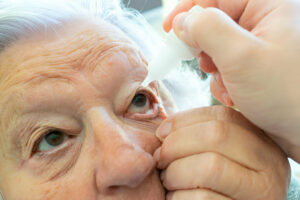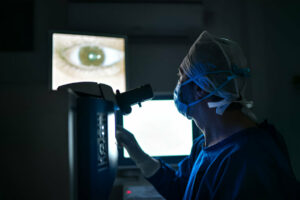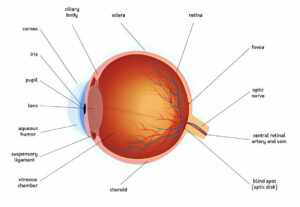
Eyes produce a clear fluid called aqueous humor which must flow in and drain out at an even rate to maintain stable intraocular pressure (IOP).
When this balance is disturbed, pressure inside of the eye increases rapidly and threatens to damage the optic nerve and lead to permanent vision loss – this condition is known as glaucoma.
Subconjunctival Hemorrhage
Conjunctiva, which covers both eyelids and surface of eyeball, contains small blood vessels. When these rupture and cause bleeding under the conjunctiva, a subconjunctival hemorrhage occurs – producing a bright red patch of skin known as subconjunctival hemorrhage that usually only affects one sector of an eye; typically lasting 4-6 weeks until slowly healing itself (similar to how bruises fade and change color over time). No specific treatment for this condition exists – however any accompanying systemic disorders such as hypertension and coagulopathies must be controlled.
Hemorrhage under the conjunctiva may result from sudden bleeding from an eye vessel or chronic conditions such as scleritis or collagen vascular disease, as well as from blunt force trauma or Valsalva maneuvers such as coughing, sneezing or straining that compress eyelid blood vessels resulting in hemorrhage. Hemorrhage can also be an indicator of severe glaucoma or high blood pressure; in these instances it should be evaluated by a physician immediately. Recurrent subconjunctival hemorrhage indicates systemic disease and should be evaluated immediately by medical professionals.
Ophthalmologists can diagnose hemorrhages using visual examination. A red patch under the eyelid, light sensitivity and itchiness may all be symptoms. A slit lamp exam may be performed to gauge its severity; during this test filter paper is placed over each inferior fornix of each eye, along with topical anesthetic for reflex tearing reduction; once in place the ophthalmologist can observe tear flow and blood movement on filter paper; hemorrhages caused by collagen vascular diseases or scleritis may blanch under this test whereas those from collagen vascular diseases will blanch under its light while those due to scleritis will not.
Patients with a history of scleritis or coagulopathies should undergo a full eye examination and be treated accordingly. If their ophthalmologist suspects bacterial conjunctivitis, gram stain and culture should be obtained and appropriate antibiotic therapy initiated immediately.
Glaucoma
At its core, healthy eyes require clear fluid known as aqueous humor to continuously circulate in and out of the front of their eye, feeding tissues while maintaining even pressure within. Unfortunately, in some people this fluid cannot drain efficiently, leading to build-ups of pressure within their eye known as glaucoma. Untreated pressure can damage the optic nerve that connects your eyes to your brain, leading to irreversible blindness (glaucoma being one of the leading causes worldwide). Glaucoma usually develops slowly over time and only becomes evident once an individual has experienced significant loss of peripheral (side) vision. There are different forms of glaucoma to consider. Open-angle glaucoma is one of the most prevalent forms of eye disease and occurs when drainage channels in the eye become blocked and not enough fluid drains away, leading to an increase in internal eye pressure and leading to an increase in its internal pressure. Other types of glaucoma include acute angle-closure glaucoma, secondary glaucoma brought on by diseases or medications, and normal tension glaucoma; wherein eye pressure remains within normal range but over time still causes progressive loss of vision.
Your doctor will perform a test for glaucoma by first using a tonometer to check your eye pressure, followed by using special drops to widen your pupils, before performing a magnifying lens exam of both eyes closely with magnifying lenses and testing peripheral (side) vision with visual field devices.
Medications prescribed to treat glaucoma aim to preserve existing vision while preventing further loss. They will require taking eye drops and medicines on an ongoing basis and reporting any side effects immediately to your physician. Glaucoma medications aim to stop further vision loss by maintaining current levels.
First-line treatments for glaucoma typically include topical beta-blockers and prostaglandin analogs, followed by alpha-2 agonists and CAIs as second and third line options respectively. If none of these medications work effectively enough for you, filtering surgery may be needed where a new passage between the sclera and chamber inside eye is created to increase drainage of aqueous humor.
Hypertensive Retinopathy
Hypertension damages the small blood vessels of the retina (the light-sensitive structure at the back of the eye). Retinal vessel walls thicken and stiffen, narrowing vessels, reducing blood supply to retina, leading to decreased vision quality as a result. Early on these changes may not cause noticeable visual symptoms but as the disease progresses they may lead to blurred vision, dark spots in field of vision, vision loss and in some instances blindness; its severity correlates with that seen elsewhere in body organs.
Hypertensive Retinopathy has historically been classified into four grades. Grade 1 symptoms include mild retinal arteriolar narrowing; grade 2 features more severe generalized arteriolar narrowing as well as focal areas; grade 3 includes hemorrhages and whitening of retinal tissues; while, finally, grade 4 or malignant hypertensive Retinopathy features yellow hard exudates (intraretinal Lipid Deposition), macular Edema, and swelling of the optic disc (Papilledema).
Recent studies indicate that hypertensive retinopathy serves as an accurate marker for systemic vascular disease in the rest of the body, and its severity can predict future heart disease risk and an increased mortality risk.
Patients with mild to moderate retinopathy typically require routine follow up and blood pressure control based on established guidelines. For those with severe retinopathy, treatment for their hypertension should be evaluated to prevent further progression and vision loss. Steroid injections or laser treatment may provide temporary solutions that could possibly stave off permanent vision loss in those living with papilledema.
Ophthalmologists can typically diagnose hypertensive retinopathy with a dilated fundus exam, and many will recommend annual exams to monitor for any new signs of hypertension. Lifestyle changes or medication are generally effective ways to lower long-term blood pressure.
Ocular Hypertension
Ocular hypertension, in which your intraocular pressure (IOP) exceeds normal, is a risk factor for glaucoma – a disease which can lead to vision loss and optic nerve damage – though usually does not cause pain or redness in the eye; diagnosis usually takes place during an eye exam when your eyecare practitioner measures your IOP compared with normal levels.
Elevated eye pressure results when your eye’s natural drainage channels, known as aqueous humor, do not function correctly and too much aqueous humor accumulates inside it, pushing against its interior surfaces and ultimately compressing retinal ganglion cells; leading to vision loss and permanent blindness if untreated.
Maintaining normal eye pressure levels is vitally important to avoiding glaucoma. You can increase your chances of lowering it by following a healthy diet, exercising regularly, cutting back on alcohol and caffeine consumption and maintaining an appropriate weight. In addition, visit your eye doctor regularly for an eye pressure exam (tonometry test).
Ocular hypertension typically does not present with symptoms or warning signs, yet should still be taken seriously as it could lead to glaucoma in later years. People who suffer from ocular hypertension have an increased risk of open-angle glaucoma, so should be monitored more carefully than usual. These individuals include those with a family history of the disease, those over age 40 and those living with diabetes or having high amounts of nearsightedness. If ocular hypertension is diagnosed in you, an eyecare practitioner can prescribe medication that will lower eye pressure. Drops, oral medications and laser surgery may all help control eye pressure; in some instances it may be necessary to combine all three methods in order to achieve target pressure reduction goals. According to The Collaborative Initial Glaucoma Treatment Study7, more than 75% of patients required two or more drugs in order to meet their reduction goal.














